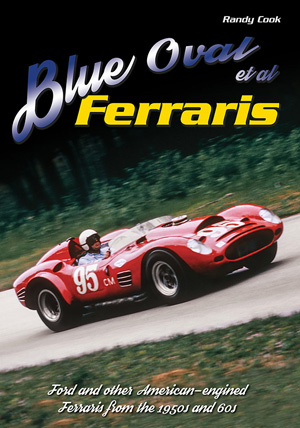 Blue Oval et al Ferraris: Ford and other American-engined Ferraris from the 1950s and 1960s
Blue Oval et al Ferraris: Ford and other American-engined Ferraris from the 1950s and 1960s
By Randy Cook
176 pages, 250 photos
$39.95 USD plus shipping
ISBN 978-0-692-50170-2
Review by Brandes Elitch
“If you haven’t grasped it yet, everything you write needs to be researched.” – Stefan Vucak
Randy Cook should need no introduction to regular readers as his previous book, “Bowtie Ferraris” was reviewed here by both this author and Michael Lynch. It told the history of 71 small block Chevy (SBC) powered cars, some of which were quite famous and had a distinguished race history. In spite of the voluminous amount of writing that has appeared on Ferraris, (probably more “scholarly research” has been written about Ferrari than any other single marque) nobody had ever tackled this subject, at least not using rigorous historical research. It is not an exaggeration that the first book changed the way that many people look at Ferraris. What Randy Cook did is to illustrate the “important and undeniable fact of Ferrari history that the temporary power of American engines saved many of the early cars, some quite significant, from being crushed and lost forever.” Make no mistake – these are the most valuable Ferraris, the early cars, and the race cars. Taken as a whole with the first book, this is an extraordinary piece of research.
After finishing the first book in 2014, other American engine cars came to light, including those with Ford (14), Buick (4), Chrysler (1), Mercedes (1), and even Offenhauser power (2). He found 31 additional cars, enough for another book, which he has just published in January, 2016. He was able to find additional material on 18 SBC cars profiled in the first book. There is a fascinating introduction by another VeloceToday regular, Toly Arutunoff. It turns out that after reading the first book, Toly realized that he actually owned an SBC engine car, a 1961 250 GT, a factory test car that crashed during practice for the 1961 Le Mans race, which Toly drove in the 1967 Targa Florio! After his ownership, an SBC was fitted. Like almost all the cars in the book, a correct Ferrari motor was subsequently fitted.
________________________________________________________________
Please support VeloceToday and subscribe for only $5 per month!
_________________________________________________________________
Both books represent an exemplary effort to compile a historical record in accordance with professional standards for such research. Randy explains that for a few years he worked as an archivist at the Motor Racing Research Center (IMRRC) in Watkins Glen, N.Y. His mentor was Michael Argetsinger, who not only wrote about motor racing, but had a distinguished racing career himself. While he worked there, Randy had access to many books, periodicals, and individual collections. More importantly, he developed personal contacts with other authors, historians, race drivers and their associates, and car owners. Bill Green, the IMRRC historian, was also very helpful. Randy also had the benefit of working professionally as a state and federal fraud investigator. This taught him the basic techniques of research and writing.
Remember, Randy was researching cars that had a previously unknown history, and was looking back perhaps fifty years for previous owners and the car’s history. Fifty years is a long time. Sometimes you can use data providers which will show previous addresses and dates of residence. That will not likely work beyond the last ten years though. Research is critical, because it provides the platform for believability and authority to the writing. Typically, this means:
-finding evidence from primary and secondary sources
-examining the sources objectively to determine who created them and why and if they are reliable
-drawing appropriate conclusions from the evidence
-setting out your own conclusions for other people to read them and discuss.
He thinks of each car as a “subject,” and then gathers all relevant data available, from whatever sources there are – books, magazines, race programs, websites, databases, etc. Whenever possible, he tried to interview “witnesses,” current or former owners or associates of owners of the subjects. Then, he made additional inquiries to validate the information, which in some cases was incomplete or inaccurate. He says that because of the low production numbers of the early cars, there is a limited universe. Of course, this research is never complete. You can always do more work trying to contact former owners. In some cases, Randy assumed that they were no longer living, only to be pleasantly surprised later on. His investigative training helped in tracking down former owners, and some of them contacted him when they found out what he was doing. Networking through sources developed at the IMRRC, along with car clubs and racing organizations, helped immensely. The actual research started in earnest about 5 years ago in a piecemeal fashion, and then got more focused as the book progressed. The first book led to the second book, and he has been encouraged to follow up with a sequel, although he is undecided at this point about doing so.

Chassis 0700 This 335S was one of 5 built by Scaglietti on the type 520 chassis in 1957, here seen at Le Mans. In 1960, it suffered a broken crankshaft at Riverside, and because it was so expensive to replace the motor, a Ford motor was installed. This car was carefully restored by Dr. John Hunholz, over a very long period of time; he owned it 25 years. He believed that the crankcase casting had a design defect which caused perennial issues with the crankshaft.
I asked him if there was one car which presented a special challenge and he replied that many of them were difficult, but car 0700 was particularly challenging, because very few people knew that it had an American motor in the past. The tip came from a VeloceToday reader. Randy spent probably six hours on the telephone speaking with John Hunholz about this. This is the 1957 Scaglietti bodied factory team car, one of 5 built on the type 520 chassis. It was driven by Phil Hill, Oliver Gendebien, Louis Klemantaski, and Peter Collins. It had great success on the track in 1957. It was later raced by Richie Ginther in California. In 1960, it suffered a broken crankshaft, and in 1964 it was fitted with a twin carb 600 h.p. Ford high-rise 427, which came out of a Ford Fairlane “Thunderbolt.” That is a very special car indeed: Ford built 100 copies in 1964 for drag racing, and took the NHRA Factory Experimental Super Stock title that year. Randy recounts all the work that Hunholz did to save the car and bring it back to its original condition, and Hunholz is indeed one of the heroes of the book.
There are a number of extraordinary cars in the book. Here are four that give a sense of what is there. While they were worth only a few thousand dollars in the fifties and sixties, they are so valuable today that they have all been restored to their original condition.
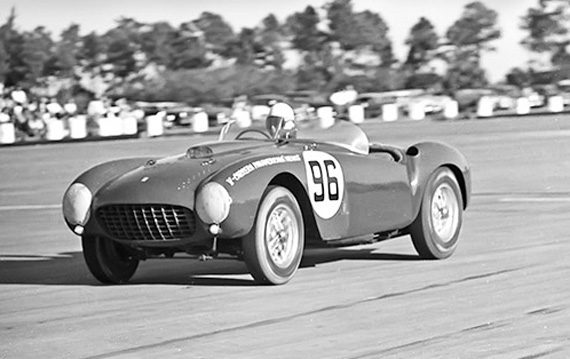
Chassis 0376 This 375 MM spyder was delivered new in 1954, and later that year it was bought by Luigi Chinetti and shown at the N.Y. Auto Show. Chinetti also drove it to 6th overall and first in class in the brutal 1954 Carrera Panamericana. It passed through various owners and was retired from racing in 1957. Ed Niles purchased it in 1968 with the Ford motor installed. Terry O’Neil photo.
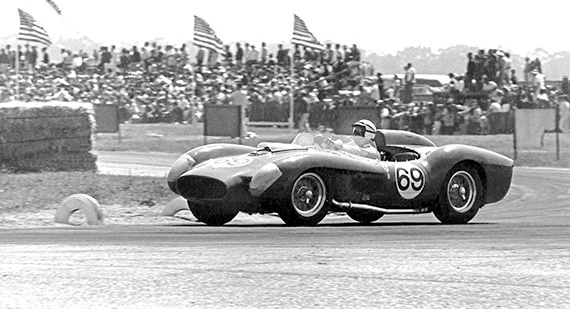
Chassis 0666 This 250 TR prototype was a 1957 factory team car. In 1958, it was raced at Le Mans and later went back to the factory to be rebuilt. In 1963, it was advertised in Road & Track for $5700. In 1964 the motor was removed and a Ford motor installed. It was reportedly set on fire because the owner though he could get more money from an insurance settlement than just selling it. In 1970, it was purchased by Charles Betz and Fred Peters, who began an 18 year restoration! Allen Kuhn Photo
[Allen Kuhn was particularly helpful with the first Bowtie book and always ready to assist others. His website is Vintage Sportscar Photos, so check it out! ed.]

Chassis 0118 Since I am rebuilding a 440 myself, I chose the only Chrysler-engined car in the book as my last choice. This is the 340 America Pentastar Special, one of five 340 Touring barchettas. It was delivered in 1951 to compete in that year’s Le Mans race. The car was raced through 1953 and then sold, apparently with no engine. Subsequently the 440 was installed, ultimately replaced in 1970 with the motor from a 365 GT. Photo courtesy Vincent Yernaux
Randy Cook has compiled a very thorough history of each car, including the owner history and the race history. The only Ferrari that seems to be left with an American V8 is the one that Randy brought to the Quail Lodge show last August. He reports that in fact he sold it since then and it now resides in England, where it will be maintained as it is now, which is pretty historically significant by itself.
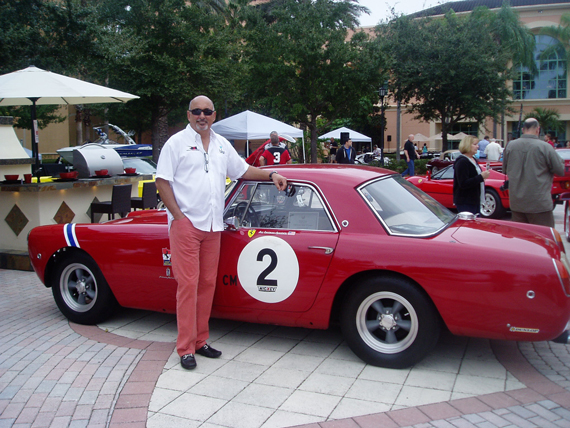
Bobby Rahal stands next to the ex-Randy Cook Ferrari; perhaps the only Ferrari left which still sports a Chevy engine.
In closing, I should also mention the contribution by VeloceToday photographer, Hugues Vanhoolandt, who seems to be just everywhere with his camera! It is always a pleasure to work with Hugues. Finally, the layout and production by Jodi Ellis Graphics is first rate and contributes very positively to the look and feel of the book. In conclusion, this is one of the most interesting Ferrari books and if you are among the tifosi it is worthy of your consideration.
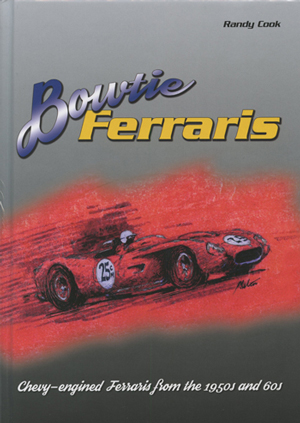
In the early 50s there was a man in Ft. Worth TX named Loren McMullen that had a Chevy engine in a Ferrari. He was a reporter for the Fort Worth Star Telegram and did some SCCA racing in the Texas Region. He sold the car to Paul Hill who was a USAF Capt./ Major stationed at Carswell AFB. Paul did some SCCA racing with the car too. Don’t know what happened to the car after I left Ft. Worth to go to USAF pilot training in 57. Did some racing in E/P myself in a Giulietta. Salad days.
Very interesting article on the 2 researches.
And, now, I wait to know what were the 9 missing cars on the 31 with Ford – Buick – Chrysler – Offy and the german Mercedes = 22 cars ……
I hope from you !!!
Hervé.
For VT readers visiting Retromobile this week Hortons Books will have this book available at their vendor booth. They likely still have copies of Bowtie Ferraris as well.
To clear up a bit of confusion over the car count in the new book, in addition to ones identified by Brandy, there is one Maserati powered car and eight additional Chevy powered cars not covered in the first book as well as a detailed revisit to 0084 from the first book.
The car Tom Arnone referred to above, 0518, is covered in my first book. It was displayed last month at the Cavallino Classic painted in its original yellow livery. Photos can be found on the Sports Car Digest website.
Very Interesting …Did Joe Marchetti ever own one of these?
For those who may not be aware of it, Randy Cook passed away in February. I only found out about it when I visited the Old Racing Car Company stand at Goodwood Members’ Meeting, where Randy’s 250 PF coupe was being displayed.
Sincere condolences to Randy’s family.